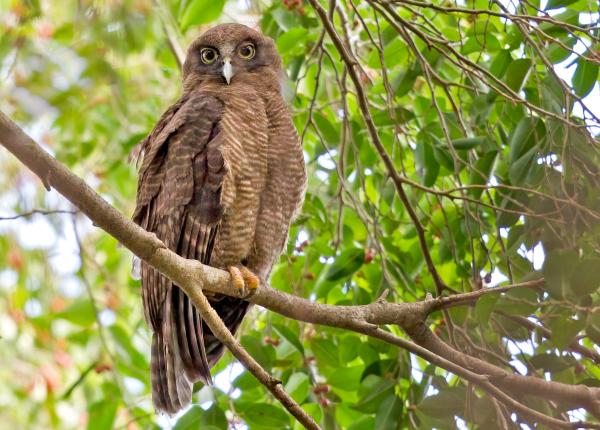Did You Know?
- There are four subspecies of the Rufous Owl
- From time to time, this owl has been known to hunt in suburban gardens
- This species is also known as the Rufous Boobook
How The Peregrine Fund is Helping
Though we don't work directly with Rufous Owls, our efforts in scientific research, habitat conservation, education, and community development help conserve birds of prey around the world. We also supply literature to researchers from our avian research library, which helps scientists around the world gather and share important information on raptor conservation. We also run the Global Raptor Impact Network which gives raptor researchers tools to more efficiently conduct their own studies while contributing to a global program. GRIN also provides citizen scientists a way to participate in raptor science and conservation.
Where it Lives
The Rufous Owl is found mainly in New Guinea and Australia. It makes its home in a variety of habitats including rainforest, woodlands, savannas, and forest edges often near water.
What it Does
As its name implies, the Rufous Owl is generally rufous in color, and it has a darker brownish back. However, the intensity of its rufous color varies from subspecies to subspecies. It has a dark facial discs, and fine barring on its belly and back. Like most owls, this large species is mostly nocturnal - meaning it is most active at night.
The call of this lovely owl has been described as a low and slow "hoo hoo." The females have a higher pitched call than the males. During breeding season, these owls become more vocal.
Why it Needs Our Help
This owl is categorized as a species of Least Concern by the IUCN. However, this does not mean that this owl doesn't face any threats. Loss of habitat, to logging and increased forest fires, and, hunting in some parts of its range will likely have detrimental effects on this species' population in the future.
What it Eats
The Rufous Owl preys principally on medium-sized terrestrial and arboreal mammals including fruit bats, marsupials, and rodents. It will also take birds and large insects. When the sun begins to set, this owl begins to hunt. It employs a number of hunting techniques such as gleaning insects from leaves or snatching prey from the ground. And it often moves through the canopy in search of prey it can catch from the branches.
Nests, Eggs, and Young
It might be surprising to learn that scientists don't know very much about the breeding biology or habits of this species. Researchers believe that pairs are monogamous, meaning the same male and female remain together for life.
Like other owls, they don't build their own nests but prefer to nest in holes or hollows in trees. The female will lay 1-2 eggs, which must be incubated for around 36 days. After the young owlets hatch, they are covered in fluffy white down. But they will grow quickly. In just about 2 months they will be ready to leave the nest. However, they will remain in their parents' territory for several more months as they learn the skills necessary for them to hunt and survive on their own.
Rufous Owl and the World Center for Birds of Prey
Though The World Center for Birds of Prey is far from the Rufous Owl's distribution, it offers fun ways to learn about and see many different birds of prey. At our visitor center, you can see live owls up close, including an Eastern and Western Screech-Owls, a Verreaux's Eagle-Owl, and an Eurasian Eagle-Owl. Come learn about the wonderful and interesting adaptations they have in order to survive in their respective habitats. There is also a touch table with owl feathers and other natural objects available for exploration, and interactive activities, tours, interesting videos, and a children's room with activities from coloring sheets to quizzes to costumes await you.
References:
Marc Anderson, XC142493. Accessible at www.xeno-canto.org/142493.
Olsen, P.D. and J. S. Marks (2020). Rufous Owl (Ninox rufa), version 1.0. In Birds of the World (J. del Hoyo, A. Elliott, J. Sargatal, D. A. Christie, and E. de Juana, Editors). Cornell Lab of Ornithology, Ithaca, NY, USA. https://doi.org/10.2173/bow.rufowl2.01










